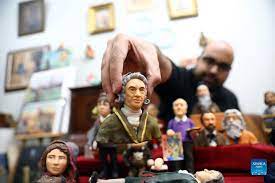On a table in downtown Cairo, Fady Francis, 30, aligns miniature sculptures of 100 influential world figures, standing side by side in harmony, although the figures were from different cultures, spoke different languages and lived in different eras in history.
Among the miniature sculptures are the mummy of Egypt’s ancient King Ramses II in his sarcophagus and the bust of China’s philosopher Confucius, surrounded by the likenesses of Egyptian writer Taha Hussein, India’s Rabindranath Tagore, German-born physicist Albert Einstein, Austrian composer Wolfgang Amadeus Mozart, and Spanish painter and sculptor Pablo Picasso.
“They gather together in one place regardless of their different languages and cultures,” the Egyptian artist and journalist says, stressing that it is the theme of his project.
Francis says his choice of Taha Hussein was because he was one of the most influential Egyptian writers in the 20th century and was referred to as “the Dean of Arabic Literature”, although he became blind in his early childhood.
“He was a figure that defied all difficulties and his influence wasn’t restricted to Egypt but extended around the world,” he adds.
Francis says the bust of Confucius was one of his latest works, noting that he visited China in 2017 and was impressed by its culture and architecture.
“He (Confucius) is a Chinese philosopher whose thoughts influenced humanity. His works were translated into different languages across the world. I chose him as a symbol of Chinese culture, thought and philosophy,” Francis says.
Francis started learning to paint during his childhood, and was inspired by the artistic nature of the antiquities in the monument-rich province of Luxor, where he was born and grew up.
Three years ago, his interest turned to sculpture. Now he uses polymer clay as the main material of his sculptures, which vary in height between 8 and 18 cm, shaping them with simple tools such as a toothpick and a needle, and using a magnifying glass to be able to complete the smallest details.
Some of the miniature statues are sculpted in a caricature-based style with bigger heads, while the focus of some busts is on the details of the facial features, such as those of Confucius and Tagore, according to the artist.
Although the first year of the COVID-19 pandemic was difficult for the world, Francis took the global lockdown that followed as a “chance” to improve his sculpting skills and managed to finish 60 miniature sculptures in 2020.
“I believe that art is a message of peace that unites all humans despite their different cultures and languages,” he says.
Source: CD
